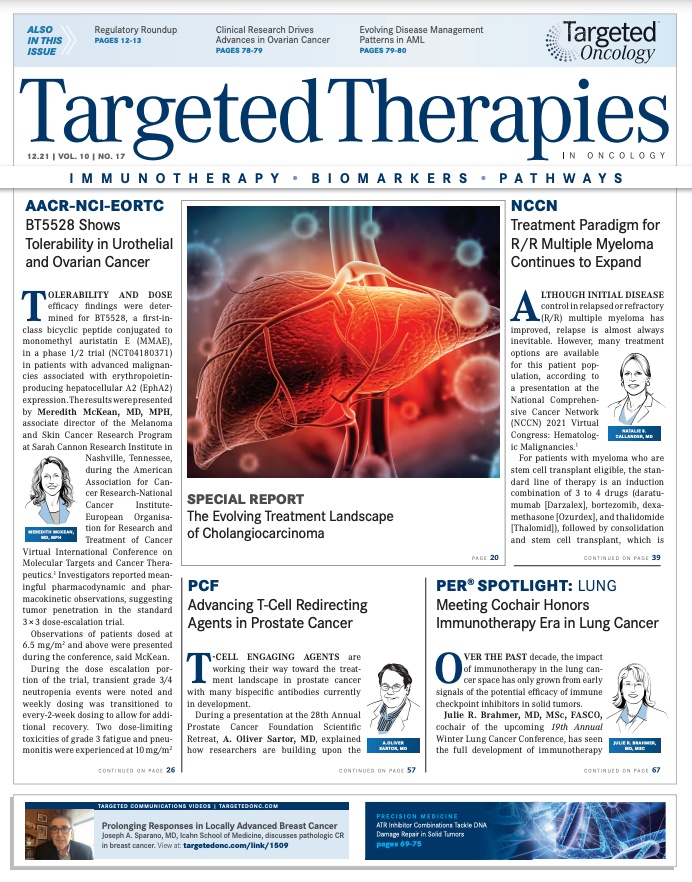Nivolumab With Rucaparib Shows Survival Benefit in HRD+, Chemotherapy-Naïve mCRPC
Survival benefit was shown with the combination of niraparib and rucaparib in patients with chemotherapy-naive metastatic castration-resistant prostate cancer.
Daniel P. Petrylak, MD

Nivolumab (Opdivo) in combination with PARP inhibitor rucaparib (Rubraca) showed a significant survival benefit in patients with chemotherapy-naïve metastatic castration-resistant prostate cancer (mCRPC) who have homologous recombination deficiency (HRD) positivity, according to results from a final analysis of a cohort from the phase 2 CheckMate 9KD trial (NCT03338790).
Both radiographic progression-free survival (rPFS) and overall survival (OS) were longer among patients with HRD positivity compared with the overall cohort population and patients with negative or not-evaluable HRD status. Objective response rates (ORR) and prostate-specific antigen (PSA) response rates were highest among patients with mutations in BRCA 1/2. Findings were detailed in a poster presentation during the 28th Annual Prostate Cancer Foundation (PCF) Scientific Retreat.
“In this cohort with chemotherapy-naïve metastatic CRPC, nivolumab with rucaparib showed clinical efficacy in patients with HRD-positive tumors, with noteworthy activity in those harboring BRCA mutations,” said Daniel P. Petrylak, MD, professor of medicine and urology at Yale School of Medicine and coleader of Cancer Signaling Networks at Yale Cancer Center in New Haven, Connecticut.
The multicohort CheckMate 9KD trial looked at combinations with nivolumab in patients with mCRPC who were undergoing ongoing androgen deprivation therapy (ADT) with a gonadotropin-releasing hormone analog or bilateral orchiectomy and had documented progression. Patients had an ECOG performance status of 0 or 1 and had no prior treatment with drugs targeting T-cell costimulation or immune checkpoint pathways.
Patients in cohort A received nivolumab 480 mg every 4 weeks plus rucaparib 600 mg twice daily. Patients who had received 1 to 2 prior taxane chemotherapy regimens and up to 2 novel hormonal therapies were in cohort A1; patients who were not candidates for or who refused immediate chemotherapy and who had received 1 to 2 prior novel hormonal therapies prechemotherapy were in cohort A2.
Patients in Cohort B were chemotherapy-naïve but eligible for docetaxel and had received up to 2 novel hormonal therapies for prechemotherapy mCRPC. They received nivolumab and docetaxel.
Patients in Cohort C received prior abiraterone (Zytiga) for prechemotherapy mCRPC without prior enzalutamide or apalutamide (Erleada) and were not candidates for or refused immediate chemotherapy. They received nivolumab plus enzalutamide (Xtandi).
Coprimary study end points were ORR and PSA response rate, defined as the proportion of patients with a 50% or higher decrease in PSA from baseline. Secondary end points were rPFS, OS, time to objective response, duration of objective response, time to PSA progression, and safety. All efficacy end points were assessed in the overall treated population as well as in patients with HRD-positive tumors. HRD status was determined by tissue and plasma assays.
The PCF poster presentation focused on patients in cohort A2. Petrylak explained that the combination was explored in this patient population because PARP inhibitors increase cellular DNA damage in tumors with DNA repair defects, which leads to genomic instability and cell death.
Cohort A2 included 71 patients who were treated with the combination of nivolumab and rucaparib. Patients were a median of 73 years (range, 51-87). The majority of patients (57.7%) had an ECOG performance status of 1 and a Gleason score above 7 (54.9%). The median time since diagnosis was 4.1 years (range, 0.4-19.6). Most patients did not have visceral metastases (67.6%), but it was not reported in 8.5%. HRD positivity was positive in 47.9%, negative in 50.7%, and not evaluable in 1.4%. Prior novel hormonal therapy included abiraterone only in 60.6%, enzalutamide only in 23.9%, and both in 14.1%.
Patients in this cohort were followed for a median of 17.5 months. The median duration of therapy was 4.6 months for nivolumab and 5.5 months for rucaparib.
At data cutoff, 91.5% of patients had discontinued all treatment due to disease progression in 60.6% and drug toxicity in 11.3%. Four patients were still on treatment at cutoff.
The ORR in all evaluable patients (n=39) was 15.4% (95% CI, 5.9%-30.5%), which consisted of all partial responses. Stable disease (SD) was achieved in 66.7% of patients. The ORR in HRD negative or not-evaluable patients (n=19) was 5.3% (95% CI, 0.1%-26.0%), and 78.9% of patients had SD.
In HRD-positive patients (n=20), the ORR was 25.0% (95% CI, 8.7%-49.1%) and 55.0% had SD. In 9 patients with BRCA 1/2 mutations, the ORR was 33.3% (95% CI, 7.5%-70.1%) and 55.6% had SD.
In all patients evaluable for PSA response (n=66), the response rate was 27.3% (95% CI, 17.0%-39.6%). In HRD negative/not-evaluable patients (n=35), the PSA response rate was 14.3% (95% CI, 4.8%-30.3%).
The PSA response rate was 41.9% (95% CI, 24.5%-60.9%) in patients with HRD positivity (n=31) and 84.6% (95% CI, 54.6%-98.1%) in patients with BRCA 1/2 mutations (n=13).
“The PSA response rate of 84.6% in patients with BRCA-positive tumors justifies further evaluation of this combination in patients with BRCA 1/2 mutations,” Petrylak said.
The median time to response was 2.0 months (range, 1.8-11.0) and the median time to PSA progression was 3.5 months (range, 2.8-6.2). The median duration of response was 7.1 months (95% CI, 3.5–not estimable [NE]).
The overall median rPFS was 8.1 months (95% CI, 5.6-10.9). Among patients with HRD negativity or not-evaluable HRD status, the median rPFS was 5.6 months (95% CI, 3.7-9.1) and 10.9 months (95% CI, 6.7-12.0) in patients with HRD positivity.
Median OS was 20.2 months (95% CI, 14.1-22.8) in the overall population. The median OS was 19.0 months (95% CI, 8.2-22.1) in patients with HRD negativity or not evaluable HRD status and 22.7 months (95% CI, 14.1-NE) in patients with HRD positivity.
Treatment-related adverse events (TRAEs) of any grade were reported in 90.1% of patients and were grade 3 or 4 in severity in 50.7%. The most common TRAEs of any grade were nausea (40.8%), anemia (32.4%), alanine aminotransferase (ALT) increase (28.2%), fatigue (28.2%), aspartate aminotransferase increase (25.4%), blood creatinine increase (21.1%), diarrhea (19.7%), decreased appetite (18.3%), vomiting (18.3%), and pruritis (15.5%). The most common grade 3/4 TRAEs were anemia in 14.1% and ALT increase in 12.7%.
TRAEs led to discontinuation in 23.9% of patients, most commonly due to anemia and increased ALT. No treatment-related deaths were reported in cohort A2.
“Longer follow-up is needed to better characterize the clinical benefits of adding nivolumab to rucaparib for patients with HRD-positive, chemotherapy-naïve metastatic CRPC,” Petrylak concluded.
Reference:
Petrylak DP, Perez-Garcia JL, Lacombe L, et al. CheckMate 9KD cohort A2 final analysis: nivolumab plus rucaparib for chemotherapy-naïve metastatic castration-resistant prostate cancer. Presented at: 2021 Prostate Cancer Foundation Scientific Retreat; October 28-November 5, 2021; virtual.
